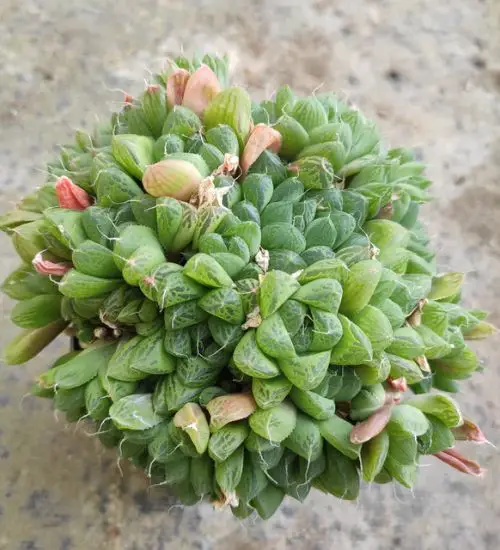Sun: Bright indoor light
Water: Below average watering needs for a succulent
Temperature: Zone 10a from 30° F to 35° F (-1.1 ° C to 1.7° C) to Zone 11b from 45° F to 50° F (7.2° C to 10° C)
Winter Survival: Not cold hardy
Propagation: offsets
Flower: in the Spring or Summer
Flower Type: Green, white
Toxic: Generally non-toxic to humans and animals
Dormant: winter
Space Requirement: Indoors
Common Problems: Plants may rot if overwatered, pests
Where to buy Haworthia Cymbiformis Obtusa?
Basc Care for Haworthia Cymbiformis Obtusa
Watering
Watering for Haworthia Cymbiformis Obtusa is a simple task. It requires Below average watering needs for a succulent.
One simple tip for you is that you can use some online apps to check the soil status before you go water your succulents. I would recommend the ThePlantsCheck app, it has some nice features there.
Fertilizing
Only feed this succulent during its active growing seasons which means winter. Use the right fertilizer applied in the right amounts. Applying half-strength balanced fertilizer every month or so is recommended for optimal results.
Do not fertilize during winter as the plant is dormant.
Sun & Location Requirements for "Haworthia Cymbiformis Obtusa"
Haworthia Cymbiformis Obtusa needs lots of sunshine! An ideal spot is near a window that gets direct sun for a few hours every day. If you don’t have natural sunlight indoors, consider investing in an LED grow-light to provide enough light for Haworthia Cymbiformis Obtusa to stay healthy and vibrant.
When temperatures drop below freezing, it is important to take precautions to protect Haworthia Cymbiformis Obtusa from the cold. Insulating and providing adequate drainage for the plant are key elements in helping it survive winter weather. Wind and sun exposure should also be minimized to prevent frost damage.
Any succulents in the group will only need minimal space to grow. You can place your pot at your table or window. Outdoors is also a nice idea to put your pot.
Haworthia Cymbiformis Obtusa also benefits from some indirect light throughout the day as well, so make sure you give it enough space to soak up light without becoming too exposed to heat.
Propagation
Offsets are an easy and reliable way to propagate succulents, like Haworthia Cymbiformis Obtusa. With just a few simple steps, you can get a brand-new plant from an existing one.
Toxicity

Haworthia Cymbiformis Obtusa is generally non-toxic to humans and animals. However, the plant may contain certain toxins which can cause mild skin irritation if it is ingested or comes in contact with skin. Therefore, it is important to keep the plant away from children and pets for safety reasons.
Pests and Diseases
Haworthia Cymbiformis Obtusa can be affected common pests and diseases like most of the other succulents such as mealybugs and scale insects.
If you do spot any of pest signs, you can treat your succulent using below methods.
- Mealybugs: quarantine, clean infected plants, soapy water.
- Scale insects: quarantine, clean infected plants, soapy water.
Besides that, to prevent serious health issues from happening, keep your succulent in a well-ventilated area and check it regularly for any signs of pests or health problems.


